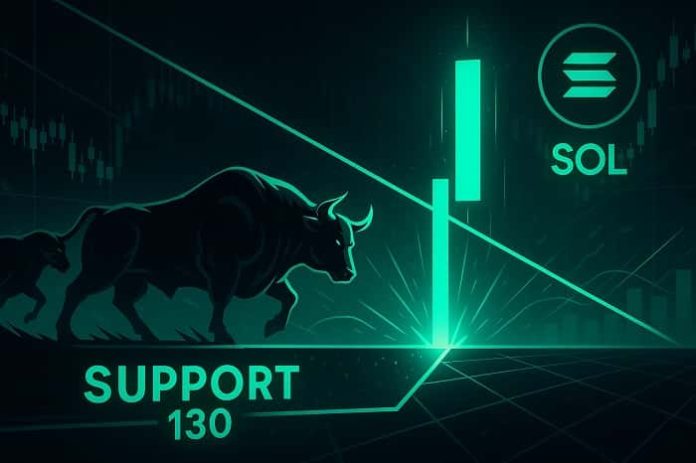
SOL Price Recovery: Is Solana Preparing for a Breakout After Hitting the Channel Low?
SOL Price Recovery The current behavior of Solana’s market structure shows that the SOL Price Recovery narrative is becoming increasingly relevant as bulls begin to react to the lower boundary of the descending channel. After price tagged the bottom of the falling structure, buyers stepped in aggressively, forming a daily bullish candle that signals renewed strength.
This is the first sign that the SOL Price Recovery phase may be developing beneath the surface as traders reassess short-term bias, structure, and potential recovery momentum.
Descending Channel Context and Structural Importance
The falling channel has been one of the key components of the SOL Price Recovery setup. Solana has repeatedly rebounded from this structure, confirming that traders are respecting the boundaries. The consistency of these reaction points suggests that the descending trend is not merely a breakdown phase but a controlled corrective structure.
Each time price meets the lower boundary, demand increases, reinforcing the broader SOL Price Recovery blueprint. This makes the current position especially important as it may mark the beginning of a short-term reversal.
Why Buyers Reacted at This Level
The bullish daily candle that appeared after the recent test of support reflects early confidence in the SOL Price Recovery scenario. This type of reaction often appears before stronger impulses form. Traders who track structural confluence understand that falling channels create compressed liquidity zones, where countertrend rallies can originate.
When price hits an exhaustion point within the channel and responds with a strong green candle, the probability of a SOL Price Recovery continuation increases. This reaction is a technical signal that buyers may be preparing for a controlled push upward.
Key Support Zone Around $130
The $130 region plays a critical role in the SOL Price Recovery structure. It represents a cluster of support levels formed by historical demand, reaction points, and overlapping trendline confluence.
As long as price remains above this zone, bulls maintain structural authority. Losing the level would weaken the immediate SOL Price Recovery narrative, potentially turning the move into a deeper corrective cycle. However, the current behavior shows that buyers are willing to defend this zone, reinforcing its importance.
Short-Term Recovery in Motion
The latest price movements indicate that the early stage of a SOL Price Recovery is unfolding.
The pattern suggests a controlled shift away from downside pressure and toward stabilization. When markets form repeated rebounds within a channel, it signals that the structure is behaving as intended: absorbing liquidity while maintaining trend integrity. The combination of bullish candles, structural support, and measured reactions hints that the SOL Price Recovery may transition into a short-term uptrend if buyers maintain momentum.
Mid-Term Target Toward $160
If the market preserves support and continues reinforcing the SOL Price Recovery pattern, the next logical target lies near the mid-line of the descending channel, around the $160 region. This level represents a natural magnet where price commonly gravitates during recovery phases.
The structure positions this target as a mid-term objective, particularly if the current bullish reaction gains confirmation through volume expansion. Traders should remain focused on how price behaves when approaching the middle boundary, as this will determine whether a larger reversal could follow.
Risks: What Could Delay the Move
Although the scenario remains strong, there are conditions that could slow or temporarily interrupt the move. A dip back below the recent reaction lows would show weakness from the buyers. If breakout attempts fail to produce volume, bullish moves may stall, creating more compression instead of continuation. Pressure beneath support would weaken the pattern, making the $130 zone critical for maintaining structure.
Volume Confirmation Matters
A confirmed requires liquidity and commitment. Recovery patterns that lack volume often fade or drift sideways. Traders must track volume on both the breakout attempts and the reaction zones. If buyers drive significant volume while reclaiming intraday resistance levels, the structure becomes more validated. Without volume, the market may simply remain inside the range.
Market Psychology Behind Recovery Patterns
Descending channels often produce controlled declines rather than panic-driven selloffs. This is why the pattern is common in high-liquidity assets. As price compresses, volatility declines, setting the stage for expansion. During these phases, traders who understand structural cycles accumulate while others wait for clearer signals. This shift from caution to aggression creates the initial fuel for arally.
Why This Rebound Matters More Than Previous Ones
The current reaction is stronger than some earlier ones, giving the thesis additional credibility. The strength of the recent candle suggests that buyers were waiting for this exact level. As long as buyers maintain their presence and price continues to close above key supports, the narrative remains on track. In comparison to earlier rebounds, this reaction showcases clearer momentum shift.
Macro and Cycle Alignment
Broad market conditions also play a role in confirming the structure. Solana remains one of the most active networks in the crypto ecosystem, with strong liquidity and ongoing development. As long as macro conditions do not deteriorate, the SOL Price Recovery pattern may align with wider market rotation into large-cap altcoins.
Final Outlook
The technical indicators, structural position, and price reaction all support the ongoing setup. While risks remain if price dips below reaction lows, the current setup favors continuation as long as support holds. Should volume confirm a breakout from the descending structure, a move toward $160 becomes increasingly likely. The SOL Price Recovery thesis remains active, and traders monitoring the pattern should keep their attention on structural levels, candle formations, and momentum shifts.
